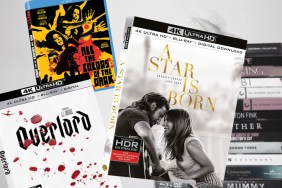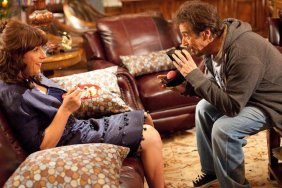Oh boy. A fun one.
Welcome, students, to the latest lesson in CraveOnline’s Free Film School. I think I’ve been pummeling you with enough theory for the time being (last week’s lesson on film-as-autobiography was particularly abstract). Let’s take a breather with a look at one of the more ubiquitous and enduring subgenres of exploitation film: the Women in Prison genre. For any youngsters who may not be familiar with exploitation films of the ‘60s and ‘70s, I can assure you that there are enough Women in Prison films to warrant an entire subgenre.
Almost everyone I know seems to like the smutty, violent, nudity-laden Women in Prison films, even gay men and straight women. There is a wondrous exploitative simplicity to these movies. Remove men from the scenario, and populate your film with nothing but “bad girls.” The film immediately writes itself. Women are going to get naked and shower together (any Women in Prison film worth its weight in cleavage will have at least one nude showering scene), there will be a few scenes of various girl gangs vying for dominance within the prison, making for some wild catfights. There will likely be a wicked pseudo-Sapphic warden of some kind who will want to either do violence to their charges, or summon them back to the warden’s office for scenes of (often forceful) lesbian seduction. There will have to be an attempted breakout, making for easy drama. Gunplay can definitely be incorporated. And some may be so bold as to depict in-prison drug-use.

But it’s not just the usual misogynist slant that makes these films popular with men (although I’m sure there are some unsavory types who enjoy watching women being abused). I think, more than that, the appeal of Women in Prison films actually tilts a little more toward the feminist. The genre sprang up, you see, in the mid-1950s. And while some of the earlier Women in Prison films were often finger-wagging cautionary tales, their appeal was seeing usually composed ladies, expected to be ladylike, entering into a decidedly non-ladylike environment. True, the target of these films were men who wanted to see nudity and catfights (I, frankly, never got a sexual thrill from catfights; give me the shower scenes any old day), but it’s not so much of a cognitive jump to go from the famous WWII poster of Rosie the Riveter, flexing her bicep for the world to see, to equally tough women surviving fights, throwing fists, and, yes, expressing their sexuality openly in a genre film. True, it’s in an enclosed environment, sealed off from the “decent” world, but I suppose these tough women were, ironically enough, allowed to be violently expressive and sexually free once they were locked up.
There might also be a kind of anarchic thrill to the Women in Prison films. The protagonists of most of these films were typically a newbie to the prison – a “Fresh Fish” – who was either taken under the wing of a more experienced inmate, or perhaps did battle with a mama hen. Either way, it was always the prisoners who were seen as the oppressed heroes, and the wardens were their tyrannical overlords. It’s easy to see the prison as a stand-in for the government (pick your country), and their tyrannical ways as a comment on any form of governmental malfeasance. If you’ve ever been dissatisfied with your own government (and who hasn’t been?), Women in Prison films offer a fantasy outlet for any anarchist leanings you may have. It would allow you to entertain fantasies of revolution.

As I said, the genre saw its evolutionary forebears in the 1950s with films like John Cromwell’s Academy Award-nominated scare film Caged (1950), which featured Agnes Moorehead in a supporting role. Caged was a critical success in 1950, but is seen today as something of a cult classic, as its moralizing and finger wagging come across as quaint. In 1955, Ida Lupino played an evil warden in Women’s Prison, which would have a made-for-TV sequel called Women in Chains in 1972. As the 1960s rolled around, dozens of “bad girl” films began entering the pop lexicon. This was also a popular time for JD (or Juvenile Delinquent) films, depicting leather-clad teenage punks running free of adult supervisions, drinking, boinking, robbing, and committing casual acts of murder. No doubt this was also brought about by WWII, and a generation raised with parents either abroad or dead or both. So there were plenty of “bad girls go to prison” films in the mix. A fun title from the 1950s: So Young, So Bad.
The 1960s also saw an influx of exploitation imports, usually more liberal with their violence and nudity than their American counterparts. Jess Franco, the famed ass-obsessed Spanish exploitation elder statesman, made 99 Women (1969), and, later Wanda the Wicked Warden (1977). If you are at all interested in exploitation cinema, I demand that you look over the extensive filmography of Jess Franco. He is a titan. Few are better known for their vast contributions to Euroschlock than he. Hunker down with 1971’s Vampyros Lesbos sometime. A fun title from the 1960s: House of 1,000 Dolls with Vincent Price. Although I think that one was, strictly speaking, a white slavery movie.

Once the 1970s began, and exploitation movies experienced a boom, Women in Prison films became properly codified, and certainly more lurid. Many consider the 1971 Roger Corman-produced AIP film The Big Doll House, directed by Jack Hill, to be the true crux of all Women in Prison films. It may be considered the crown jewel of the genre. It’s certainly the most important American Women in Prison film. It also was an early film appearance of busty, black, B-movies goddess Pam Grier, who would appear in more than one Women in Prison film, including one or two that took place in ancient Rome. It was by now that all the genre’s tropes were properly codified, and all the character archetypes were in full force. Over the course of the decade, Corman would have a hand in dozens of these things, all following similar stories, all featuring scads of busty and tough-talking women, all featuring plentiful nudity, shower scenes, drugs, fights, and wicked wardens and wardenesses. Corman was a true man of his time, and was always willing to include a (very often hokey) speech about the nature of justice and the inhumanity of the government.
Indeed, none of the prisons in Women in Prison movies were well-run institutions, featuring calm and introspective women who were contemplating their crimes. Nor were they ever Edenic and brightly-lit settings for playful sex romps and giggly lesbian experimentation; we have German schoolgirl films for that. No. The prisons were invariably corrupt, dank, and violent places rife with sexually repressed or oversexed authorities fond of beatings and voyeurism. Sometimes even the entire criminal justice system was the corrupt system, and women were wrongfully imprisoned or over-criminalized, just to sate the sexual and violent appetites of corrupt, fascistic legal officials. I haven’t visited too many prisons, and I have yet to serve any jail time, so I can’t personally attest to the cinematic fealty of these on-screen institutions, but I’m guessing that none of them were accurate portrayals of actual prison life. Indeed, none of the Corman-era Women in Prison films were filmed in actual prisons. Most were filmed on sets in The Philippines. Despite the cheapness of the sets, and the international tax breaks, Women in Prison films were a notoriously more expensive form of exploitation movie. They did, however, always make money, hence their ubiquity.

The 1970s also saw the rise of oddball Nazi sex films, spearheaded by movies like 1974’s Ilsa: She-Wolf of the SS, and its dubiously canonical sequels. Even though Corman was taking care of the caged lady flick here at home, Europe did not slow its production of Women in Prison movies, and if it’s bad dubbing, Nazi uniforms and Euroschlock you prefer, you have plenty to choose from. Clearly the European films were more concerned with the echoes of Nazism and Fascism and the prison offshoots therein. A fun Euroschlock title from the ‘70s: Nazi Love Camp 27. Another: The Gestapo’s Last Orgy.
It’s a sad fact that most Women in Prison films are largely indistinguishable from one another. They may have a gimmick, a nice performance, or skilled photography or filmmaking, but there are so familiar that they may as well all be the same. Like P.G. Wodehouse stories with tits, Women in Prison films all eventually run into one another (you may notice that I’m not giving many plot synopses). But also like Wodehouse, you can re-read them, and not be bored, experiencing the same thrill, and becoming addicted to the formulae.
Many famous directors cut their teeth on some of these films. In addition to Jack Hill (who would go on to direct The Big Bird Cage, and the Pam Grier vehicles Coffy, and Foxy Brown), the Academy Award-winner Jonathan Demme (The Silence of the Lambs, Rachel Getting Married) would get his start with 1974’s Caged Heat.

Eventually, Women in Prison films waned in popularity, as cheaper-to-make slashers cut into the attention of exploitation filmmakers, and the 1980s VHS boom allowed pornography to enter the home, drawing attention away from the nudity only previously attainable (for many audiences) through exploitation movies. Sure, there were a few Women in Prison films to come out during the 1980s, but these were stylistic homages more than the genuine article. Although I will stand by both Chained Heat movies (1983 and 1991 respectively), as the first features a sexy Linda Blair as the Fresh Fish. And I have an enormous celebrity crush on scream queen Jewel Shepard, star of 1994’s Caged Heat 2: Stripped of Freedom. I haven’t yet seem the sci-fi update Caged Heat 3000 (1995). Perhaps I ought to. One of the Women in Prison homages to look for is 1985’s Reform School Girls, which features Sybil Danning as the evil warden, and the ultra-badass rock goddess Wendy O. Williams as the in-prison thug. Williams also sings the theme song. Reform School Girls is a cult film unto itself.
What was the last Women in Prison movie I saw? I think 1999’s Brokedown Palace might count, although the flavor of the late ‘90s is decidedly different from the genre’s ‘70s heyday. Thanks to the rise of Quentin Tarantino, all homages to 1970s exploitation movies have to be kind of cheeky and self-aware. I think the glory of the Women in Prison movies is how cheap and straightforward they are. It’s hard to make something self-aware whose strength comes from its earnestness.
Luckily, all these films easily stand the test of time. They are pure, fun, cheesy, sexy, violent, offensive, raw, and awesome. The way exploitation oughtta be.
Homework for the Week:
If you’re only going to see one Women in Prison film, see The Big Doll House. If you’re going to see two, also see Caged Heat. Do you like Women in Prison movies? What makes them fun? What makes them repellant? What makes them anarchic fun, and what makes them horrifying? Can a film genre that banks on the exploitation of women, and features scads of female nudity, still be considered a feminist object?








